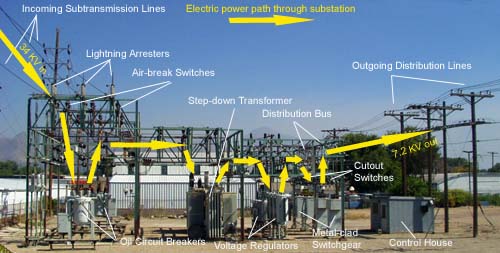An electrical substation is a critical node in the power system: it serves as the bridge between electricity generation/transmission and the end-user distribution network. Without substations, the electricity generated at power plants could not be efficiently transmitted over long distances and safely delivered for homes, industries or businesses.
In this guide we will cover what an electrical substation is, how it works, its main components, types, functions, design considerations, safety aspects and why it matters.
Article Content
Definition & Role
At its core:
- A substation is a facility where voltage levels are changed (stepped up or stepped down), circuits are switched, and power flow is controlled to ensure reliable distribution.
- It may transform from high-voltage (HV) for transmission down to medium (MV) or low voltage (LV) for distribution.
- It also handles protection (fault clearance), monitoring, switching and ensures system stability.
Why it matters:
- Long-distance transmission at high voltage reduces losses, but end use demands lower, safe voltages. The substation facilitates this change.
- Without proper substations, electricity supply would be unstable, inefficient and unsafe.
How an Electrical Substation Works
Here’s a simplified breakdown of operations:
- Input from transmission lines: High voltage lines bring power to the substation.
- Voltage transformation: Using transformers, voltage is either stepped-up (for transmission) or stepped-down (for distribution).
- Switching and protection: Circuit breakers, switches and relays monitor and isolate parts of the network when faults occur.
- Distribution or onward transmission: After processing, the electricity is sent to other substations or to the distribution network for final consumption.
- Control and monitoring: Modern substations include SCADA systems, instrumentation and automation to monitor performance and respond to issues.

Important note: The design ensures minimal power loss, high reliability, and safe operations. For instance, raising voltage reduces losses because losses ∝ 1/V² as shown in theoretical power system studies.
Main Components of an Electrical Substation
Let’s look at the key parts that make up a substation:
- Transformers – Step up or step down voltage levels.
- Switchgear / Circuit Breakers – Interrupt or redirect electrical flows during normal operation or fault conditions.
- Busbars – Conductors that collect and distribute current.
- Disconnect switches / Isolators – Provide visible isolation for maintenance and safety.
- Lightning arresters / Surge protection – Protect equipment from surges and lightning events.
- Instrument Transformers (CTs & PTs) – Provide measurement and protection input (current transformers, potential/voltage transformers).
- Grounding / Earthing systems – Critical for safety and fault current dissipation.
- Control building / SCADA – Houses monitoring, control and automation systems.
Each of these components plays a distinct role; missing/inadequate components degrade reliability, safety or efficiency.
Types of Electrical Substations
Different substations serve different purposes. Some of the common types include:
- Transmission Substation: Operates at high voltage, often steps up voltage for transmission or interconnects transmission lines.
- Distribution Substation: Steps voltage down from transmission levels to distribution levels for homes/businesses.
- Switching Substation: May not have large transformers, but majorly switches circuits and routes power.
- Collector / Renewable Energy Substation: Designed to collect power (e.g., from a wind farm) and feed into the grid at required voltage. (Emerging)
- Gas-Insulated Substation (GIS): Uses gas-insulated switchgear for compact footprint, often in urban/space-restrained locations.
When selecting or designing a substation, the type must align with system voltage levels, load demands, configuration and future expansion.
Design & Location Considerations
Designing an electrical substation involves numerous factors:
- Load growth and projections: The design must accommodate future demand.
- Voltage levels: Choosing appropriate primary and secondary voltages.
- Space & layout: Clearance distances, safety zones, distance between equipment.
- Environmental & regulatory: Noise, visual impact, land usage, environmental assessments.
- Safety & earthing/grounding: To handle fault currents and protect personnel.
- Flexibility & reliability: Ability to isolate faults, maintain equipment, and operate with minimal downtime.
- Technology integration: Such as automation, remote monitoring, integration of renewables.
Well-designed substations are both efficient and future-proof.
Safety Aspects
Working with high voltages inherently carries risk. Some safety aspects to highlight:
- Proper grounding/earthing systems ensure that fault currents find safe paths to earth rather than through people or equipment.
- Adequate clearances and zoning prevent arcing, flash-over, and protect maintenance personnel.
- Protection devices (relays, breakers) must act quickly to isolate faults and prevent larger failures.
- Regular maintenance and inspection are essential to detect deterioration (e.g., insulation, corrosion) before explosion or failure.
- Compliance with standards and regulations ensures that designs meet legal and technical safety requirements.
Why Electrical Substations Are Critical
- Enables efficient and safe distribution of electricity from generation to end-use.
- Maintains grid stability by controlling voltage levels and fault isolation.
- Supports modern power systems including renewable energy integration, microgrids and distributed generation.
- Minimises losses and improves reliability by being appropriately located and configured.
In short, substations are one of the fundamental building blocks of our electricity infrastructure.
Conclusion
If you remember one thing: an electrical substation is the junction where electricity’s journey from generation through high-voltage transmission is converted and managed for safe, efficient delivery to end users. It houses many pieces of equipment (transformers, switchgear, protection systems) that together make this possible.
Frequently Asked Questions (FAQ)
What is the difference between a transmission substation and a distribution substation?
A transmission substation typically handles very high voltages (step-up/step-down for transmission lines) and may interconnect multiple high-voltage lines. A distribution substation steps down voltage further for local distribution to homes and businesses.
Does an electrical substation generate electricity?
No — substations do not generate power. They transform, switch and distribute power generated by plants.
Can substations be inside buildings or underground?
Yes — depending on space, environmental, visual restrictions, substations may be indoor, underground or compact (e.g., GIS).
Closing
Understanding electrical substations is just the beginning — but knowing how the protection systems in a substation work is what truly ensures grid reliability and safety.
Read Next: How the Protection Systems in a Substation Work
